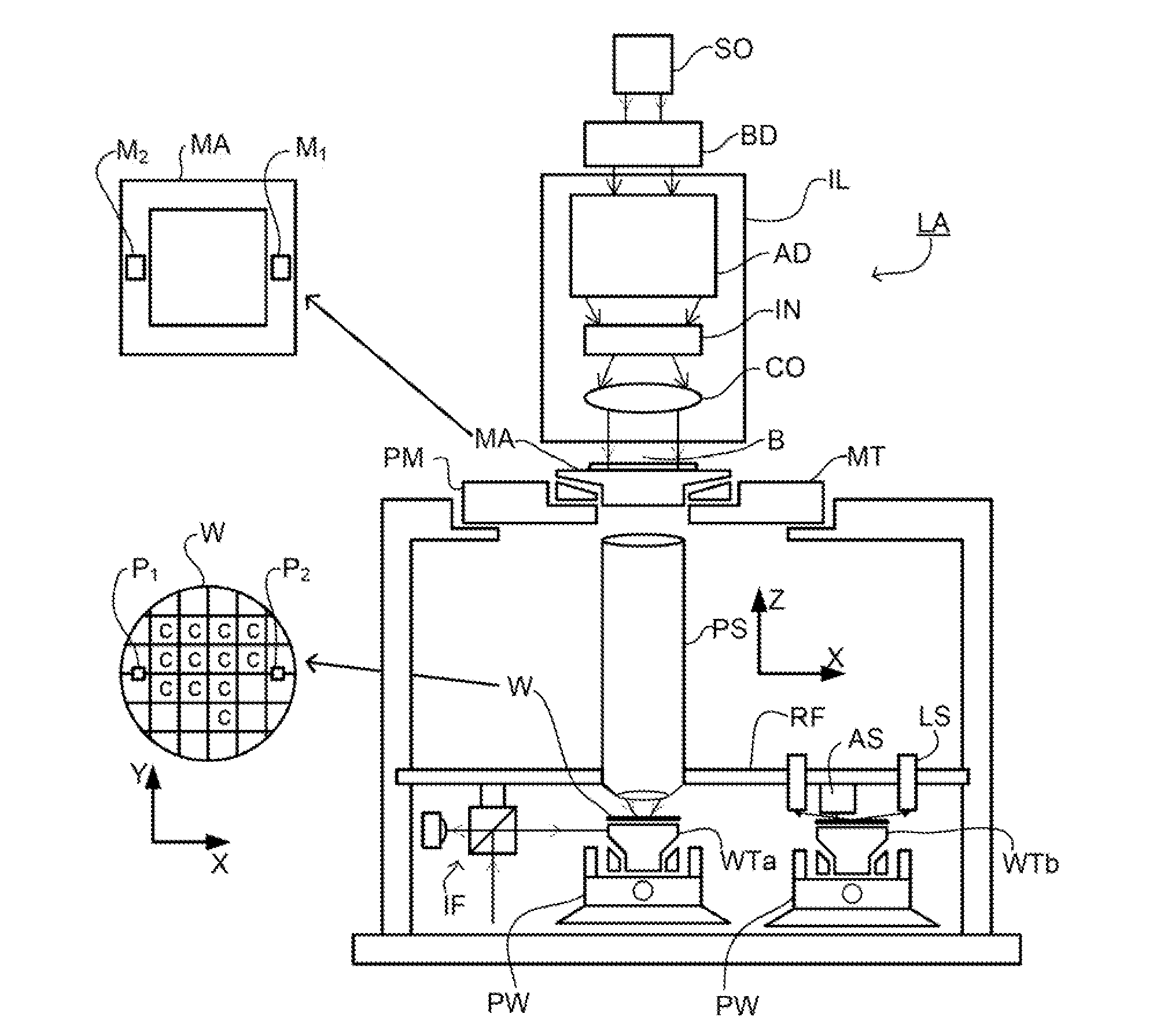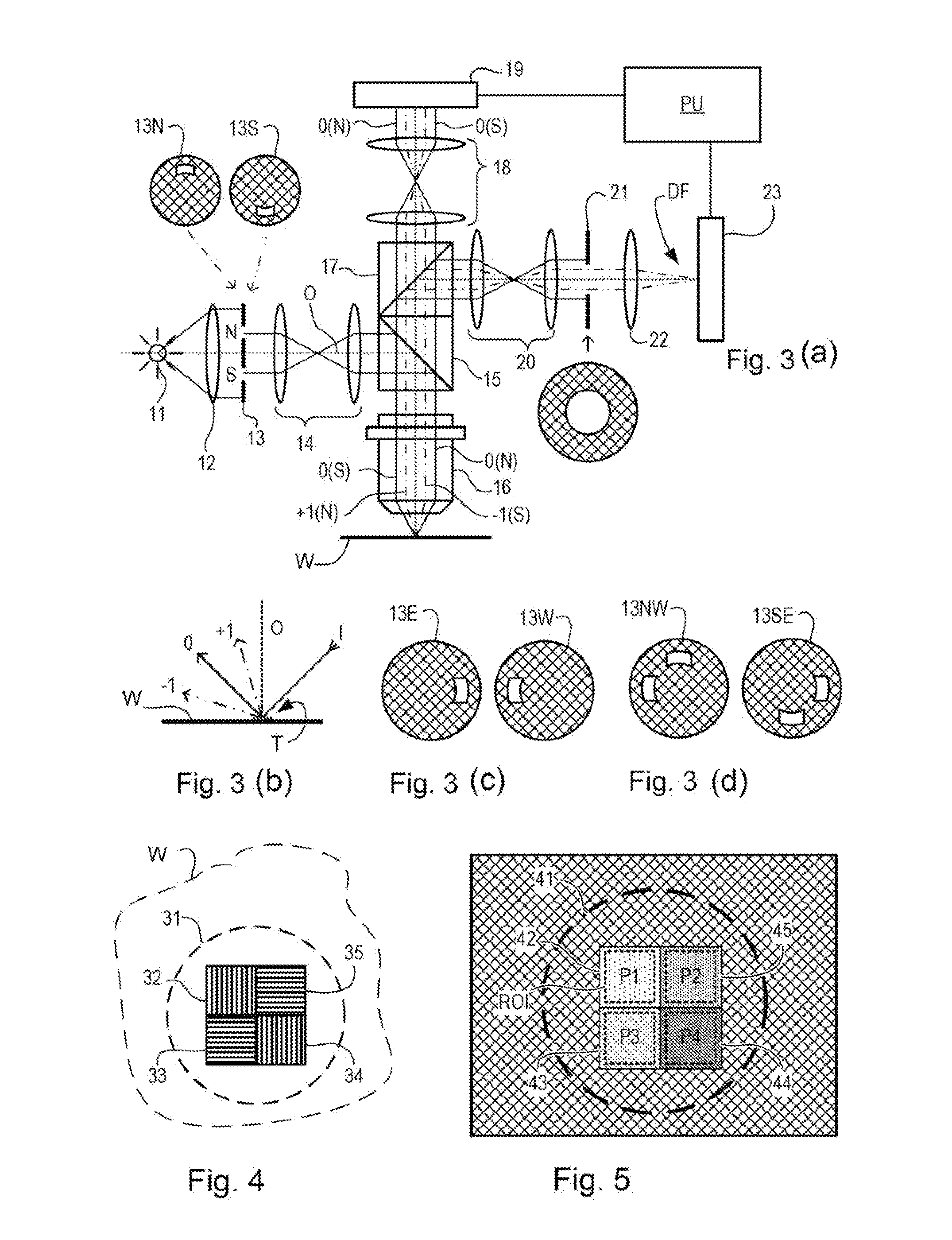Metrology Method and Apparatus, Lithographic System and Device Manufacturing Method
- Summary
- Abstract
- Description
- Claims
- Application Information
AI Technical Summary
Benefits of technology
Problems solved by technology
Method used
Image
Examples
example 1
Solving for K0, K1, and ov with 3 gratings
[0092]Target (a) in FIG. 9 includes three component gratings with a symmetric bias scheme (−d, 0, and +d). To solve for the first harmonic and for a constant asymmetry signal coming from the bottom-grating asymmetry (BGA) we can write:
ΔI+=K0+K1·sin(ov+d)
ΔI0=K0+K1·sin(ov)
ΔI−=K0+K1·sin(ov−d)
where ΔI is the intensity difference representing the measured asymmetry and the suffix ‘+’, ‘0’ or ‘−’ indicates the bias.
[0093]The solution of this set of equations can be written as:
ov=atan{[ΔI++ΔI--2ΔI0]·sin(d)[ΔI+-ΔI-]·(cos(d)-1)}K0=ΔI++ΔI--2ΔI0·cos(d)2·(1-cos(d))K1=[ΔI+-ΔI-]2·sin(d)·1+([ΔI++ΔI--2ΔI0]·sin(d)[ΔI+-ΔI-]·(cos(d)-1))2
[0094]This gives a direct calculation of the overlay, taking a constant asymmetry offset into account for the BGA or other feature asymmetry. We suggest to use a range of bias that is a significant proportion of the grating pitch P, to ensure that the curvature of the sine function is captured by the three sample points, and is...
example 2
Solving for K0, K1, and ov with 4 gratings
[0095]For the targets with four biased gratings, shown in FIGS. 9 (b), (c) and (d), the following equations can be written:
ΔI−d−Δd=K0+K1·sin(ov−d−Δd)
ΔI−d+Δd=K0+K1·sin(ov−d+Δd)
ΔI+d−Δd=K0+K1·sin(ov+d−Δd)
ΔI+d+Δd=K0+K1·sin(ov+d+Δd)
[0096]Solving for the unknown parameters yields:
ov=atan{((ΔI-d+Δd-ΔI-d-Δd)-(ΔI+d+Δd-ΔI+d-Δd))·sin(d-Δd)2·(ΔI+d-Δd-ΔI-d+Δd)·sin(d)·sin(Δd)}K0=(ΔI+d+Δd+ΔI-d-Δd)·cos(d-Δd)-(ΔI+d-Δd+ΔI-d+Δd)·cos(d+Δd)2·(cos(d+Δd)-cos(d-Δd))K1=(ΔI+d-Δd-ΔI-d+Δd)2·sin(d-Δd)×1+(((ΔI-d+Δd-ΔI-d-Δd)-(ΔI+d+Δd-ΔI+d-Δd))·sin(d-Δd)2·(ΔI+d-Δd-ΔI-d+Δd)·sin(d)·sin(Δd))2
[0097]Again, the range of biases should be significant as a proportion of the grating pitch P. For example it is suggested to use in this case a bias d=40 nm and a sub-bias Δd=20 nm, where the pitch P=500 nm. The biases thus range from +60 nm to −60 nm, that is a range of 120 nm overall. Here also, this is relatively large, representing more than 20% but less than 9% of the pitch, and wil...
example 3
Solving for K0, K1, K2, and ov with 4 gratings and 2nd harmonic
[0098]For the 4-gratings per target case above, also the second harmonic can be included if the design of the gratings and the optical system requires it. We can write:
ΔI−d−Δd=K0+K1·sin(ov−d−Δd)+K2·sin(2·(ov−d−Δd))
ΔI−d+Δd=K0+K1·sin(ov−d+Δd)+K2·sin(2·(ov−d+Δd))
ΔI+d−Δd=K0+K1·sin(ov+d−Δd)+K2·sin(2·(ov+d−Δd))
ΔI+d+Δd=K0+K1·sin(ov+d+Δd)+K2·sin(2·(ov+d+Δd))
[0099]To solve this set of equations we defining some new parameters as:
ΔIa=ΔI+d+Δd-ΔI-d-ΔdΔIb=ΔI+d-Δd-ΔI+d-ΔdΔIc=(ΔI+d+Δd-ΔI+d-Δd)-(ΔI-d+Δd-ΔI-d-Δd)wherea1=2·sin(d+Δd)a2=2·sin(2·(d+Δd))b1=2·sin(d-Δd)b2=2·sin(2·(d-Δd))c1=-4·sin(d)·sin(Δd)c2=-4·sin(2d)·sin(2Δd)andz0=(a1b2-a2b1)·ΔIcc1·(b2ΔIa-a2ΔIb)z1=(2·b1c2-b2c1)·ΔIa+(a2c1-2·a1c2)·ΔIbc1·(b2ΔIa-a2ΔIb)Q=3·z1-z029R=2·z02-9·z0·(z1+3)54D=Q3+R2S=R+Q3T=R-Q3
[0100]The equations can then be solved, yielding three possible solutions:
ov1=atan{z03+(S+T)}ov2=atan{z03-12(S+T)+12·i·3(S-T)}ov3=atan{z03-12(S+T)-12·i·3(S-T)}
[0101]Of these result...
PUM
| Property | Measurement | Unit |
|---|---|---|
| Fraction | aaaaa | aaaaa |
| Fraction | aaaaa | aaaaa |
| Fraction | aaaaa | aaaaa |
Abstract
Description
Claims
Application Information
 Login to View More
Login to View More - R&D
- Intellectual Property
- Life Sciences
- Materials
- Tech Scout
- Unparalleled Data Quality
- Higher Quality Content
- 60% Fewer Hallucinations
Browse by: Latest US Patents, China's latest patents, Technical Efficacy Thesaurus, Application Domain, Technology Topic, Popular Technical Reports.
© 2025 PatSnap. All rights reserved.Legal|Privacy policy|Modern Slavery Act Transparency Statement|Sitemap|About US| Contact US: help@patsnap.com



